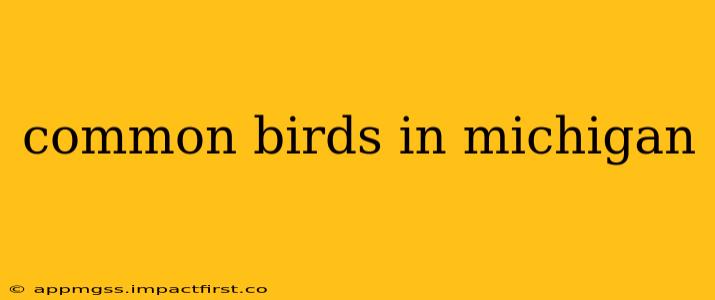Michigan's diverse landscapes, from the Great Lakes shoreline to its inland forests and prairies, support a rich variety of birdlife. This guide explores some of the most common birds you'll encounter in the state, offering insights into their identification, habitat preferences, and behaviors. Whether you're a seasoned birder or just starting out, this resource will help you appreciate the avian wonders of Michigan.
What are some of the most common birds in Michigan?
This depends heavily on the season and location within Michigan, but some species are consistently prevalent throughout the state. These include the ubiquitous American Robin, the cheerful Northern Cardinal, the adaptable Downy Woodpecker, and the ever-present Black-capped Chickadee. These species are easily identifiable and offer great starting points for beginning birders. More specific examples and seasonal variations will be discussed further below.
What birds are in Michigan in the summer?
Summer in Michigan sees an influx of migratory birds, adding to the resident population. Expect to see:
- Warblers: Several warbler species, known for their vibrant colors and lively songs, breed in Michigan's forests during the summer months. Yellow-rumped Warblers are particularly common and easy to spot.
- Swallows: Barn Swallows and Tree Swallows are common sights, gracefully swooping and diving to catch insects.
- Flycatchers: Eastern Kingbirds and Great Crested Flycatchers can be found in open woodlands and along edges of forests.
- Hummingbirds: Ruby-throated Hummingbirds are a welcome addition to summer gardens, attracted to flowering plants.
What birds are in Michigan in the winter?
Winter brings a different avian cast to Michigan. While many species migrate south, several hardy birds remain:
- Northern Cardinals: These bright red birds are a cheerful sight even in the snow.
- Black-capped Chickadees: These tiny, energetic birds are highly adaptable and easily spotted at feeders.
- Downy Woodpeckers: These small woodpeckers are frequent visitors to backyard feeders.
- Blue Jays: Bold and noisy, Blue Jays are a common sight year-round.
- Snow Buntings: These striking white birds arrive in winter, often seen in large flocks in open fields.
What are some common backyard birds in Michigan?
Many of the birds mentioned above are regular visitors to backyard feeders and gardens. To attract a wider variety, consider offering a diverse range of food sources, including seeds, nuts, suet, and nectar. Providing fresh water and shelter through shrubs and trees also helps. Specifically, you're likely to see:
- American Goldfinches: These birds are attracted to thistle seed feeders.
- House Finches: Often found at feeders, particularly those offering sunflower seeds.
- Mourning Doves: These gentle birds are common visitors to ground feeders.
What are the best places to birdwatch in Michigan?
Michigan boasts numerous excellent birdwatching locations, catering to various preferences. Some popular spots include:
- Point Pelee National Park (Ontario, Canada - close proximity): While technically in Canada, it’s a short trip from Michigan and a renowned migratory bird hotspot.
- Sleeping Bear Dunes National Lakeshore: This area offers diverse habitats, supporting a wide range of bird species.
- Seney National Wildlife Refuge: A crucial stopover point for migratory birds, offering exceptional birdwatching opportunities.
- Various state parks and wildlife areas: Across the state, these areas provide protected habitats and opportunities for birdwatching.
How can I identify Michigan birds?
Several resources can assist with bird identification:
- Field guides: Numerous field guides are available, specifically those focused on North American birds.
- Bird identification apps: Mobile apps provide visual identification tools, often with sound recordings for verification.
- Local birding clubs and organizations: Joining a local birding group provides opportunities for guided bird walks and expert advice.
By combining keen observation skills with reliable resources, you can confidently identify many common Michigan birds. Happy birding!
